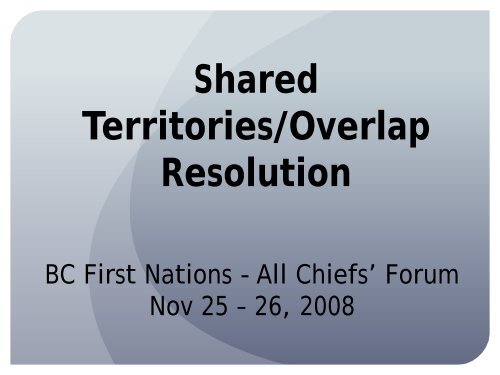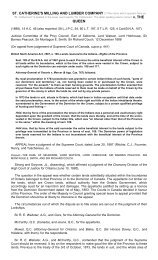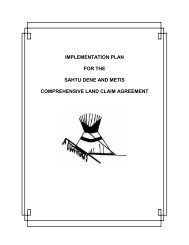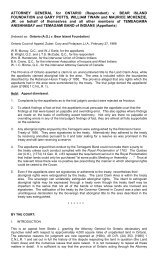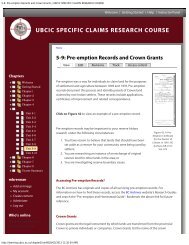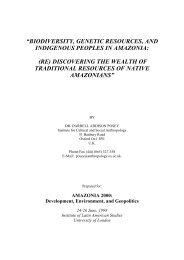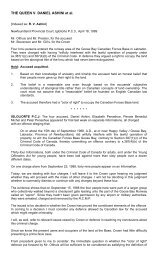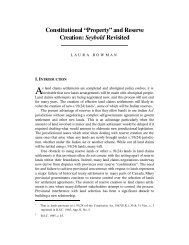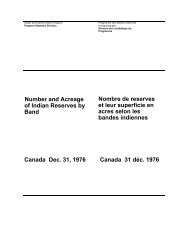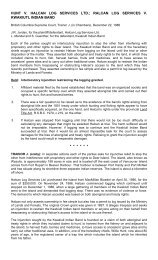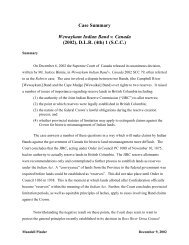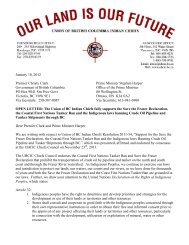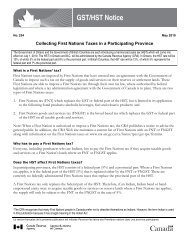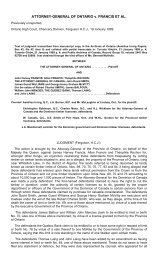Shared Territories/Overlap Resolution - Union of British Columbia ...
Shared Territories/Overlap Resolution - Union of British Columbia ...
Shared Territories/Overlap Resolution - Union of British Columbia ...
- No tags were found...
Create successful ePaper yourself
Turn your PDF publications into a flip-book with our unique Google optimized e-Paper software.
SHARED TERRITORIES/OVERLAPS• The issue <strong>of</strong> shared territories/overlaps is onethat all First Nations in BC, to varying degrees arefaced with• The term typically refers to situations wheremore than one First Nation asserts Aboriginal titleto a particular geographic area• For both the Province and First Nations, there isan increasing urgency to resolve issues <strong>of</strong> sharedterritory or overlaps.
RESOLVING SHARED TERRITORY ISSUES• The predominant understanding from a non-Aboriginal perspective, <strong>of</strong> the shared territories/overlap issue is that it is a “map drawing” exercise toidentify boundaries where the territory <strong>of</strong> one Nationends and another begins. This is problematic andreflects a common law and Eurocentric concept <strong>of</strong>what the issue is and what it means to resolve it• First Nations did not historically manage complexinterrelations through clarification and adoption <strong>of</strong>boarders on a map. Rather, this was done through arange <strong>of</strong> mechanisms
INDIGENOUS TITLE vs. ABORIGINAL TITLEIndigenous Title:• Is the inherent and sovereign title that a First Nationholds according to Indigenous law. Indigenous title cannotbe understood or defined through reference to eitherconstitutional or common law. It is a legal relationship tothe land which is defined by those Indigenous laws andlegal systems which have governed First Nations sincetime immemorialAboriginal Title:• Aboriginal title is a legally recognized interest in land asdefined by constitutional and common law. It is a legalconstruct that is defined as being in relation to theCrowns’ asserted sovereignty and interest in the land
INDIGENOUS LAWS – THE TOOL FORRESOLVING THE SHARED TERRITORY ISSUE• Resolving the shared territory/overlap issue canbe understood as the process <strong>of</strong> applying andimplementing Indigenous laws to guide howFirst nations’ Indigenous Titles intersect andinteract• In this respect, the act <strong>of</strong> resolving the sharedterritory/overlap issue is an exercise <strong>of</strong>sovereignty and autonomy, which will then guidethe understanding and evolution <strong>of</strong> howAboriginal title is defined and understood underthe common law
EXISTING MECHANISMS & PROCESSES• Currently there exists no established method <strong>of</strong>dealing with the shared territory/overlap issueand Canadian Courts are generally ill equipped toaddress the issue and are <strong>of</strong>ten an expensiveroute• The diversity <strong>of</strong> First Nations requires a diversity<strong>of</strong> approaches to resolve the sharedterritory/overlap issue. There is no “one size fitsall” process to be employed• Several approaches have been proposed oremployed in Canada and elsewhere
COMMON ASSUMPTIONSIn determining which process to implement, it isassumed that First Nations share common assumptionsincluding:• Since time immemorial, First Nations have applied andimplemented traditional laws• First Nations are engaged in a common struggle toachieve recognition and respect <strong>of</strong> their sovereignty,governments, laws, Title and Rights, and• First Nations will suffer when the Crown is given theopportunity to exploit divisions resulting from sharedterritory/overlap issues
OPTIONSExamples <strong>of</strong> proposed or employed mechanisms to address the sharedterritory/overlap issue include:1. Joint Working Groups: directly negotiating through mutuallyacceptable processes, making recommendations for resolution andworking from a joint set <strong>of</strong> principles that guide the work <strong>of</strong> thegroup2. Elders Council: to facilitate process, provide guidance on IndigenousLaws, and help guide a consultative process towards agreement3. New Institutions: create neutral Indigenous Institutions to inquireinto overlap disputes, hear information and work with parties todiscuss and develop optional agreements4. Binding Agreements: create template agreements that the partiescan employ and would result in a binding decision (e.g. <strong>Overlap</strong>Claims <strong>Resolution</strong> Agreement as provided by the National Native TitleTribunal <strong>of</strong> Australia)
INDIGENOUS TITLE COUNCIL• An example <strong>of</strong> a potential new institution could bea body such as an “Indigenous Title Council <strong>of</strong><strong>British</strong> <strong>Columbia</strong>” (or some other such name)• The intent is for such a body to be a neutral, nonaffiliated,Aboriginal institution to provide disputeresolution services and support to First Nationsseeking to resolve overlaps• Such a body would have core internal capacities,but would also likely draw on the external expertise<strong>of</strong> individuals to assist in areas such as disputeresolution
INDIGENOUS TITLE COUNCIL:ROLES & RESPONSIBILITIESThe general roles <strong>of</strong> such a body would include the following:• Research, design and development <strong>of</strong> template processes forthe resolution <strong>of</strong> shared territory/overlap disputes• To facilitate the development and implementation <strong>of</strong> aprocess <strong>of</strong> shared territory/overlap resolution, at the request<strong>of</strong> First Nations• At the request <strong>of</strong> First Nations, play a neutral role withinshared territory/overlap resolution process, includingmediating, and where appropriate, arbitrating• Depending on the nature <strong>of</strong> the process, and at the request <strong>of</strong>the Nations, the body may play a binding decision-making role
CONCLUSION• While it was never their choice, First Nations inBC have been divided into “Indian Bands” underthe Indian Act. It is understood and acknowledgedthat the process <strong>of</strong> reconstituting First Nations’governments and sorting out territorial issues ispart <strong>of</strong> the process <strong>of</strong> decolonization• While the resolution <strong>of</strong> shared territories/overlapsis primarily an issue to be addressed by FirstNations, it requires a commitment by the Crownto provide resources to support the process


